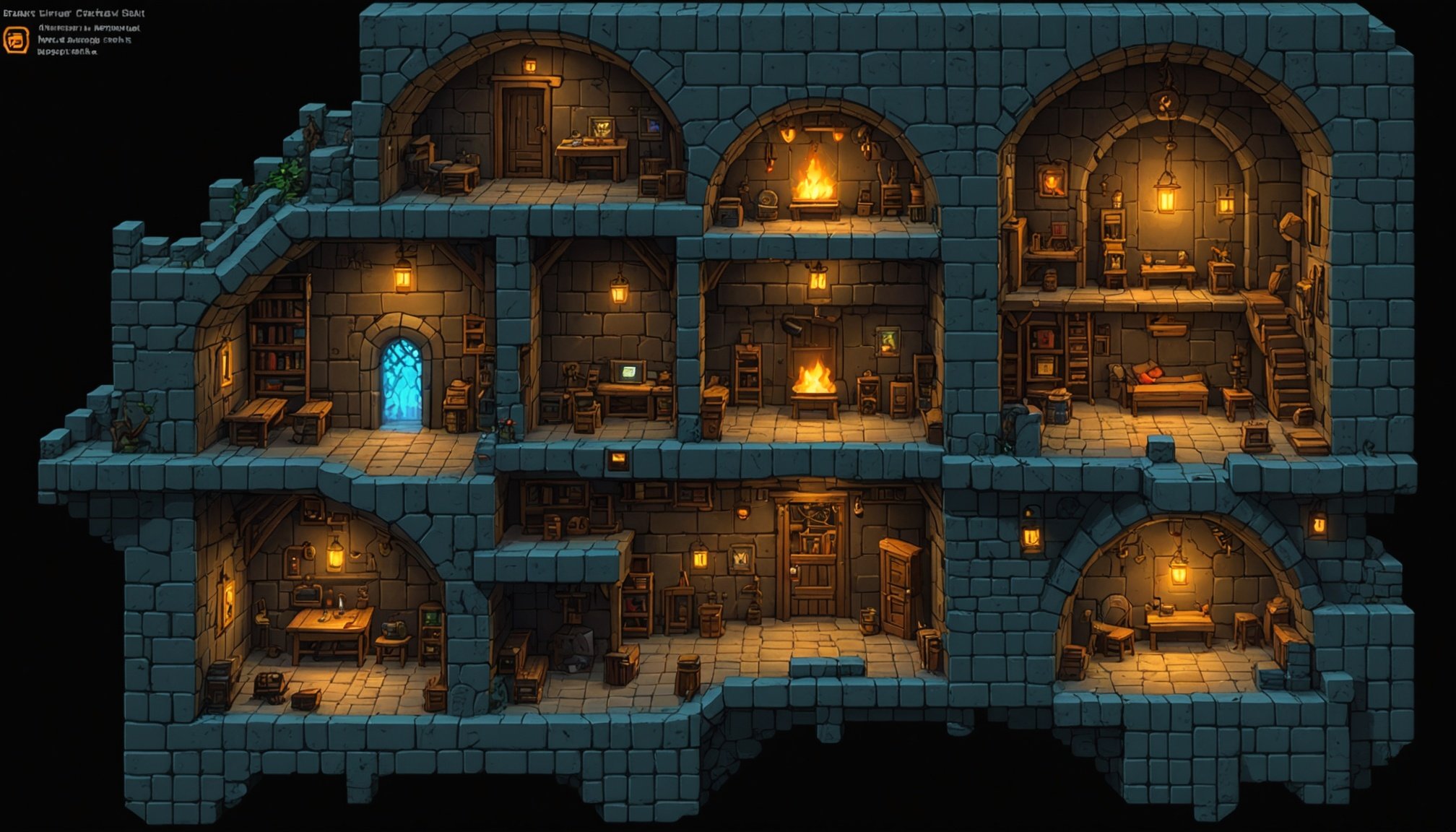Understanding Algorithmic Design Principles in Game Development
In the realm of game development principles, algorithmic design is foundational. It encompasses the methodologies used to guide the structure and mechanics of games, ensuring that developers create dynamic and engaging experiences. Among these principles, procedural generation plays a pivotal role, especially in roguelike mechanics, which rely on algorithmic designs to offer unpredictability and replayability.
Procedural generation automates the creation of game content, turning a finite set of rules into infinite possibilities. This is particularly crucial in roguelikes, where no two playthroughs are identical, keeping players engaged. By implementing algorithmic design strategies, developers create expansive and varied in-game environments that constantly evolve.
Additional reading : Unveiling the transformative power of ai-enhanced custom storylines in interactive story games
The key mechanics of engaging level design include randomness combined with strategic logic, ensuring that every layer of gameplay feels fresh yet coherent. Roguelike mechanics like permadeath and random level layouts leverage these principles to thrill and challenge players. The focus on algorithmic design helps maintain balance by adjusting difficulty levels dynamically, making it both accessible to newcomers and challenging to veterans. Understanding and applying these principles allows developers to craft games that are not only playable but stand the test of time with their depth and complexity.
Innovative AI Techniques for Level Design
In the evolving landscape of video game development, the integration of AI techniques is reshaping how level design is approached. With a focus on level design innovation, developers are now employing cutting-edge methodologies to create more immersive experiences.
In the same genre : Maximize your gaming fun: a guide to using mods for an enhanced experience
Machine Learning in Game Environments
Machine learning has paved the way for intriguing possibilities in generating game environments. By analyzing vast amounts of data, machine learning algorithms learn patterns and ultimately enhance the design process. The algorithms adapt dynamically, responding to the player’s actions to maintain interest.
Neural Networks for Dynamic Design
Neural networks, a subset of AI, revolutionise procedural generation by creating adaptable game worlds. These networks dynamically adjust game elements, providing a unique playthrough each time. It allows environments to evolve based on player interactions, ensuring no two experiences are identical.
Genetic Algorithms for Evolving Levels
Genetic algorithms offer an innovative twist on level design. By mimicking evolutionary processes, they develop and refine game levels through iterative testing and selection. This technique ensures levels adapt in complexity, catering to diverse player skills and preferences. Through these AI techniques, game design not only benefits from heightened creativity but also from the efficiency and novel experiences they afford.
Case Studies of AI in Roguelike Game Development
Exploring case studies provides a practical lens into successful AI implementation within roguelike games. Notable titles like “Spelunky” and “Binding of Isaac” showcase how AI-driven development can innovate player experiences. These games utilize AI to create unpredictable environments that keep players engaged with each session. This adaptability stems from AI’s ability to analyze and respond to player actions, crafting a unique narrative every time.
Traditional vs. AI-Driven Approaches
Comparing traditional and AI-driven level design offers valuable insights. Traditional methods often rely on static designs, making levels predictable after multiple playthroughs. In contrast, AI-driven design allows for algorithmic alterations and more dynamic adjustments, ensuring longevity in gameplay. These roguelike successes highlight how AI can maintain engagement through varied paths and challenges, adapting to different player styles.
Key Takeaways
Success in AI implementations within roguelikes aligns with leveraging robust algorithms to ensure dynamic gameplay. These case studies emphasize integrating AI techniques early in development to exploit its full potential. By doing so, developers can harness AI’s capacity to innovate and solve traditional design challenges, ultimately revolutionizing player experience in a genre defined by its unpredictability and depth.
Practical Applications and Tools for Developers
In the world of game development, harnessing the power of AI techniques and the right tools can make all the difference. Developers looking to incorporate procedural generation and level design innovation need to be equipped with practical resources and strategies.
Recommended Software and Libraries
For those starting out, there are several software tools and libraries tailored for AI-driven design. Popular choices include Unity’s ML-Agents for machine learning applications and TensorFlow for building neural networks. These platforms offer robust algorithms and pre-built environments, enabling developers to rapidly test and refine their ideas.
Tips for Integrating AI in Game Design
When integrating AI in game design, developers should focus on iterative testing and adaptation. Start with small, manageable projects to experiment with different algorithms. Prioritize learning from player feedback to optimize and expand the AI capabilities in your games.
Best Practices for Procedural Generation
Procedural generation benefits from thoughtful planning and execution. Best practices include defining clear rules and boundaries to ensure content remains coherent and engaging. Use procedural generation to create diverse environments that maintain a balance between randomness and player familiarity.
With these tools and strategies, game developers can effectively implement AI innovations and enhance the complexity and replayability of their games.
Enhancing User Experience through Visual Aids
Incorporating visual aids significantly improves the user experience in game development, especially when navigating intricate AI concepts. They not only facilitate understanding but also bolster engagement by making complex information accessible and appealing. For instance, diagrammatic representations can transform complicated algorithmic explanations into more digestible formats for developers and players alike.
Consider integrating visual elements into educational tutorials to clarify procedural generation or AI-driven design processes. This tactic ensures that players and developers can grasp intricate details without feeling overwhelmed. Example visualizations might include concept maps to outline game mechanics or animations to depict AI decision-making pathways.
When developing games, leveraging visual aids can aid in the seamless integration of design elements. Implementing interactive tutorials that utilise visuals can guide users through gameplay mechanics, thereby enhancing their learning curve and overall experience.
For developers, visual tools like flowcharts and wireframes are invaluable in planning and refining game design projects. They provide a tangible description of procedural sequences, helping to align team objectives. Using visual aids in both development and player-facing contexts encapsulates the potential for richer, more engaging content, benefiting both creators and users in the process.
Future of AI in Roguelike Level Design
In examining the future trends of AI in roguelike level design, it’s clear that technological advancements will continue reshaping the landscape. With every stride in AI advancements, roguelike mechanics are set to become even more complex and immersive.
Predictions for Next-Gen Level Design
Next-generation level design will likely leverage AI to refine procedural generation, creating even more unpredictable and engaging environments. By harnessing intricate algorithms, developers can offer increasingly dynamic gameplay experiences that constantly adapt to player behaviour.
Emerging Technologies in Game Development
Emerging technologies such as quantum computing and enhanced graphics engines are poised to further impact game development processes. These tools potentially enable more sophisticated AI models, increasing the depth and richness of in-game worlds.
Implications for Player Engagement
The role of AI in enhancing player interaction is pivotal. As AI systems grow more refined, they can deliver personalised content tailored to individual preferences, maintaining engagement and ensuring lasting interest. Roguelike games will benefit from these developments, offering players unique challenges that evolve based on their gameplay style.
As these technologies unfold, the fusion of AI advancements and roguelike evolution will foster unprecedented levels of creativity and innovation, captivating players in entirely new ways.











